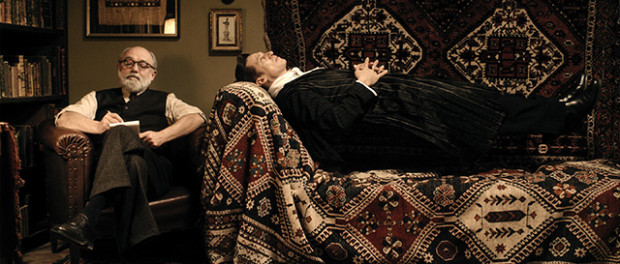Fantasia Festival Presents Dracula’s Comical Brethren
There is no better way to introduce a vampireesque comedy than with some solid horror animation. Thus, on July 17th 2015, Montreal’s Fantasia Festival preceded the Austrian movie Therapy for a Vampire (David Ruhm) by quite a gripping short film. The Mill at Calder’s End (Kevin McTurk) uses splendidly creepy wax puppets to narrate the dark tale of a young man seeking to confront a curse that has plagued his family for generations. The medium selected for the portrayal of such a shady story helps create characters with very humane features, strangely watery eyes, an unsettling plasticity and eerily immobile faces. To a dismal organ’s hymn, our main character, a young count, rides his carriage through a barren land of dark plains, burnt tree stumps and sinewy roads, on the search for a run-down mill – the source of his family’s monstrous curse. While he begins pouring oil about the damned building to set it aflame, our young protagonist is lead by curiosity through an underground passageway where several terrifying (and masterfully poignant) surprises await him. Naturally, such a dark take on what looks reminiscent of Madame Tussaud’s wax statues could not have been complete without the input of the talented Ryan Murphy (creator of American Horror Story). Therefore, with an artistically refined stroke, a chilling mood has been set for the rest of the screening.
Therapy for a Vampire is set in 1930s Vienna, the glamorous home to quite an unhappy vampire couple. Meet Count Geza von Kozsnom who, having lost his “thirst for life” and unable to stand his wife anymore, resorts to nightly therapy sessions with a pretty silly depiction of Sigmund Freud. The immortal pair’s marital troubles are quite an inevitable phenomenon (indeed, many marriages today cannot even withstand the trial of a decade), but one can sense a lot more turbulence along the horizon. The Countess is becoming increasingly obsessed with her appearance. Not having seen herself in centuries (vampires are neither visible through mirrors nor photography), she cannot count on her disinterested husband to honestly tell her what she looks like. Alas, the thin-lipped aristocrat – with her perfectly lacquered hair bob and a sinister habit of sadistically killing her prey – goes on the hunt for a painter who can accurately depict her appearance. Coincidentally, Viktor, the young artist finally selected by the Countess to fulfil her desire (“If you do not paint me with your method, I will kill you – with my method”) is sexually involved with the mesmerizing Lucy, a confused young girl who bears a striking resemblance with the Count’s lost love, Nadilah. Thus begins an intricate web of plots, mixing characters solely acting upon hollow motives and accompanied by some bloody brilliant vampire puns.
I personally really appreciated the whole film’s absurdity, beautifully contrasted with a sombre European setting and a phonetically harsh German dialogue (I’ll blame WWII Hollywood movies for permanently ruining the German language for me). One-dimensional characters with no moral depth really reinforce how ludicrous this work is. An overall lack of empathy towards any of the characters cleverly pushes viewers to focus on the ridicule of the movie. And the humour is delicious – so light and so clever, so punny and full of social commentary on marriage, human relationships, vanity… Unfortunately, after a while, the jokes do get a tad redundant, and the movie ends up feeling very long and empty. At least, this comedy never once has the pretention of taking itself seriously and Therapy for a Vampire does not end on some sort of corny moral lecture (a common flaw of many American comedies). Welcome to a darkly superficial world created by the master of vampire puns and the king of distorting the supernatural genre. Just imagine Tim Burton’s Dark Shadows with a more European twist. Never before have I encountered vampires with such an obsessive (and distracting) compulsion for counting – a compulsion that can sometimes take control in the most crucial of moments. So take a generous bite out of this juicy intrigue, and indulge in its oddly humorous flavours.
Rating: ***1/2
Best Quote: “Tell me how I look, Darling. Or do you want to sleep in the graveyard tonight?”








